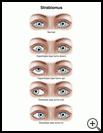
Eyes Point in Different Directions (Strabismus)
________________________________________________________________________
KEY POINTS
- Strabismus is a condition in which your child’s eyes point in different directions.
- Treatment depends on the cause and may include patching the stronger eye, glasses, eye exercises, medicine, or surgery.
________________________________________________________________________
What is strabismus?
Strabismus is a condition in which your child’s eyes point in different directions. Usually one eye is pointed straight ahead and the other is pointed in a different direction.
Some common terms for strabismus are "cross eyed," which means that one or both eyes turn toward your child’s nose or "wall eyed," which means one or both eyes turn out toward your child’s ears.
What is the cause?
There are 6 muscles that work together to move each eye. Strabismus can happen when those muscles do not work together. This may be caused by a problem with the muscles, nerves, or a problem in your child’s brain. Most people with strabismus are born with it and it tends to run in families. Strabismus may also be caused by:
- Eye or head injuries
- Diseases that affect the nerves or muscles such as cerebral palsy or Down syndrome
- Brain tumors
When your child’s eyes do not work together to look at an object, your child’s brain may cause him to see double. The brain may pay attention to the image from one eye and ignore the image from the other eye. This is called amblyopia or “lazy eye.” If treatment does not take place early, the lazy eye may never see as well as the stronger eye.
Sometimes the cause of strabismus is unknown.
What are the symptoms?
Symptoms may happen all the time, or only when your child is tired or sick. Symptoms may include:
- One or both eyes that appear to be turned in different directions
- Double vision
- Shutting one eye in outdoor light or squinting one or both eyes
How is it diagnosed?
For an infant, your provider may hold a small light in front of your baby's eyes to check if the reflection of this light is properly centered in each eye. In another test, your provider covers one of your child's eyes and then the other to see if your child’s eyes shift abnormally when focusing on a near or distant object.
Your provider will test your child’s vision and ability to follow objects with each eye. In older children, the provider will test if your child’s eyes can work well together by checking for three-dimensional vision. He or she will also examine your child’s eyes for any signs of disease.
How is it treated?
Children who have strabismus need to be treated as soon as possible so that they can develop normal vision. Treatment that begins after the age of 6 years may improve a child's appearance but does not always help vision problems.
Treatment may include:
- Patching or using prescription eye drops in the stronger eye: This treatment forces your child’s brain to pay attention to the weak eye. The weak eye works harder and develops more normally.
- Surgery on your child’s eye muscles: Muscles may be loosened, tightened, or repositioned. Strabismus surgery is not cosmetic surgery. Having eyes that are not aligned normally interferes with your child’s ability to communicate with others through eye contact. Strabismus also affects the ability to judge distance and depth. More than one surgery may be needed. The success of surgery depends partly on the coordination between your child’s eyes and brain. It needs to be good enough to keep your child’s eyes focused on an object and working together.
- Glasses: Glasses used to correct farsightedness can help focus your child’s eyes and help keep your child’s eyes from crossing.
- Eye exercises: These exercises train your child’s eyes to move together and focus on the same object at the same time. Most forms of strabismus do not improve with eye exercises.
- Injections: If an overactive eye muscle is the cause of the strabismus, small amounts of botulinum toxin A can be injected into the muscles near the eye for children age 12 and older. This may weaken or stop the muscles on one side and allow the muscles on the other side to work harder. The shots can last several months and may even cause a permanent change.
How can I take care of my child?
Follow the full course of treatment your healthcare provider prescribes. Ask your healthcare provider:
- How and when you will get your child’s test results
- How long it will take to recover
- If there are activities your child should avoid and when he can return to his normal activities
- How to take care of your child at home
- What symptoms or problems you should watch for and what to do if your child has them
Make sure you know when your child should come back for a checkup. Keep all appointments for provider visits or tests.
Last modified: 2016-03-23
Last reviewed: 2017-10-02

